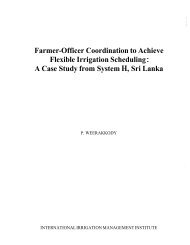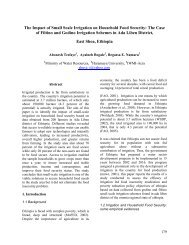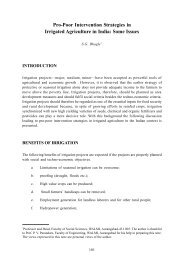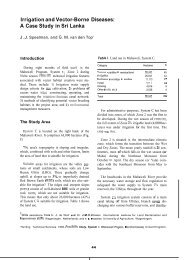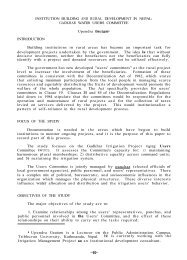WATER POVERTY IN THE NORTHEASTERN HILL REGION (INDIA)
WATER POVERTY IN THE NORTHEASTERN HILL REGION (INDIA)
WATER POVERTY IN THE NORTHEASTERN HILL REGION (INDIA)
Create successful ePaper yourself
Turn your PDF publications into a flip-book with our unique Google optimized e-Paper software.
<strong>WATER</strong> <strong>POVERTY</strong> <strong>IN</strong> <strong>THE</strong> NOR<strong>THE</strong>ASTERN <strong>HILL</strong> <strong>REGION</strong> (<strong>IN</strong>DIA): POTENTIAL ALLEVIATION THROUGH MULTIPLE-USE <strong>WATER</strong> SYSTEMSmeasures are some of the dominant factors that cause and/ or intensify floods in the northeast region’.The flood hazard of as recent as 2004 was the most serious. The excessive precipitation besides causingcatastrophic flood hazards in plains and dangerous landslides, also causes excessive leaching lossesmaking the soils impoverished and acidic. Numerous springs, small streams and rivulets and largeamounts of continuous base flows suitable to meet water deficits during non-rainy periods largelyremain unutilised.The vast water resources of the region make little contributions towards economic activities. Againstan ultimate irrigation potential of about 4.26 M ha in the region, the area presently under irrigationis less than 20 % of the potential. Only 4.3% of existing groundwater potential has been developed sofar although availability of groundwater at relatively shallow depth (< 20 m) is very high in the region(Goswami and Das, 2003). Sourcewise irrigation potential developed in the NE region states is givenin Table 1. Inspite of the abundant water resources, the ratio of percent irrigated area to net sown areavaries from about 5 percent in Asom to 28 percent in Arunachal Pradesh with the average for the NEregion as a whole at 10.6 %. This is less than one-fouth of the national average of net irrigated area inthe country which currently stands at 43.2 %.Non-availability of irrigation water, especially during the non-rainy season either discourages farmersto use adequate inputs for crop production or retain the cultivated land as fallow. Even during therainy season, terminal droughts due to early withdrawal of monsoon are quite common. This leadsto poor crop yields and little incentive for diversified or high value agriculture (Sharma, 1996).Assured water supply, though for a limited area, is a pre-requisite for moving up the value chain andsustainable livelihoods. Additionally, non-availability of water for minimal domestic and livestockneeds causes water poverty and miseries to the population and is a major contributing factor forspread of a number of malnutrition and sanitation related diseases.The structure of economy of the states in the region indicates a low level of development. The shareof prinmary in the Net State Domestic Products (NSDP) is between 30 and 40% and share ofTable 1: Sourcewise net irrigated area* (‘000 hectare) in the northeast region states of IndiaTotal netirrigatedareaPercent irrigatedarea to net sownareaStateNet sownarea Canals TanksWells/TubewellsOthersourcesAsom 2,774 33 3 11 93 140 5.0Arunachal Pradesh 164 - - - 46 46 28.0Manipur 215 - - - 48 48 22.3Meghalaya 229 59 - - - 59 25.8Mizoram 94 15 - - - 15 15.9Nagaland 321 - - - 66 66 20.6Sikkim 110 1 - - 7 8 7.3Tripura 280 15 2 9 35 61 21.8N E Region 4,187 123 5 20 295 443 10.6* (Average over the years 2000 -2006)6



